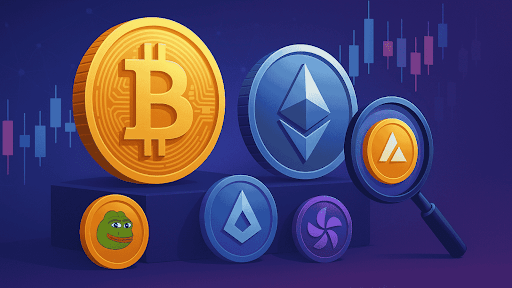As the cryptocurrency market once again flirts with bullish momentum, the hunt for promising altcoins is gaining pace among both seasoned investors and newcomers. With Bitcoin stabilizing above key resistance levels and Ethereum holding its ground, the altcoin landscape is ripe for exploration. Yet, picking the right altcoin isn’t as simple as chasing recent pumps or following social media hype. It requires a blend of on-chain analysis, macroeconomic insight, and real utility assessment.
So how do you identify the altcoins that could outperform the market in the next bull run? In this article, we dive deep into the practical indicators, underlying technologies, and strategic timing that can help investors discover high-potential altcoins before they go parabolic.
The Bull Run Cycle: Why Timing Matters
To identify the best altcoins, one must first understand the structure of a crypto bull run. Typically, a bull run begins with Bitcoin making new highs. Capital then rotates into Ethereum, followed by larger-cap altcoins, and finally into mid- and low-cap assets—the so-called “altseason”. This flow of liquidity creates opportunities for outsized gains in smaller tokens but also comes with significantly higher risk.
Recognizing where we are in this cycle is crucial. As of late June 2025, Bitcoin has regained strong upward momentum following positive economic data from the US and improved regulatory clarity. This has set the stage for altcoins to begin their run, especially as investor confidence returns and trading volumes increase across decentralized exchanges.
Fundamentals First: Look Beyond the Hype
The most sustainable altcoin rallies are driven by strong fundamentals rather than marketing hype. Key factors to evaluate include:
- Use Case and Utility: Does the token solve a real-world problem or improve blockchain infrastructure? Projects like Chainlink (oracle services) and Arbitrum (layer-2 scaling) thrived in previous cycles due to their tangible value.
- Developer Activity: Active GitHub repositories and regular updates often reflect serious, ongoing development. Platforms like Santiment or CryptoMiso can help track developer contributions.
- Tokenomics: The supply schedule, inflation model, and staking incentives matter. A deflationary model or real yield offering via staking can add long-term value to holders.
- Partnerships and Ecosystem Integration: Tokens that are adopted in DeFi, gaming, or enterprise use cases have higher staying power.
A coin that checks these boxes is more likely to withstand market volatility and deliver solid returns when the broader market turns bullish.
Social Sentiment Can Be Misleading—But Also Useful
While social media often fuels unsustainable hype, it can also be an early signal for momentum. Platforms like LunarCrush and Santiment provide sentiment analysis by tracking mentions, engagement, and influencer impact. An uptick in positive mentions accompanied by rising trading volume can indicate growing investor interest.
However, relying solely on sentiment is risky. Always combine these signals with on-chain data and technical analysis to make informed decisions.
On-Chain Metrics: The Hidden Clues
Blockchain data can provide critical insights that traditional charts often miss. Some key metrics to watch include:
- Active Addresses and Daily Transactions: A surge in usage signals growing adoption and network strength.
- Whale Activity: Large holders accumulating a token often precede a price surge.
- Exchange Inflows/Outflows: Tokens moving off centralized exchanges into cold wallets often suggest long-term holding sentiment.
On-chain analytics platforms like Glassnode, Token Terminal, and Nansen offer deep insights that can confirm or challenge market narratives.
Technical Patterns That Matter
Even fundamentally sound altcoins can underperform if bought at the wrong time. Technical analysis helps in spotting ideal entry points. Look for:
- Breakouts from consolidation zones
- Retests of major support levels
- Relative strength compared to Bitcoin and Ethereum
For instance, if an altcoin is forming higher lows while BTC trades sideways, it may be preparing for an independent breakout.
Volume is also a key indicator. Sustained increases in volume confirm the strength of price movements and help avoid false breakouts.
Real-World Examples Gaining Traction in 2025
As of late June 2025, several altcoins are emerging as early leaders in this new phase:
- Injective (INJ): Riding the AI and DeFi wave with strong developer activity and partnerships
- Celestia (TIA): Gaining attention as modular blockchain interest grows
- Sui and Aptos: Layer-1 chains that have shown resilience and institutional backing
- Render (RNDR): Benefiting from rising demand in decentralized GPU computing
These tokens exhibit a mix of strong fundamentals, growing ecosystems, and positive price structures.
Diversification and Risk Management
No matter how strong an altcoin looks, diversification remains critical. Allocate capital across different sectors—DeFi, gaming, infrastructure, and AI—to spread risk. Don’t overexpose yourself to low-cap coins unless your risk appetite is high.
Use stop-losses, take partial profits during rallies, and don’t ignore market sentiment shifts. The most successful altcoin investors know when to ride the wave—and when to exit.
Final Thoughts
Finding the best altcoins for a bull run isn’t about chasing headlines or Twitter trends. It’s a process of combining macro awareness, deep research, and patient timing. In the current climate—bolstered by renewed institutional interest and clearer regulatory frameworks—altcoins are poised to offer exponential returns. But only for those who do their homework.
Keep tracking developer updates, watch trading volume, monitor social chatter cautiously, and stay ahead of the market cycles. The next big winner may already be quietly building under the radar.


